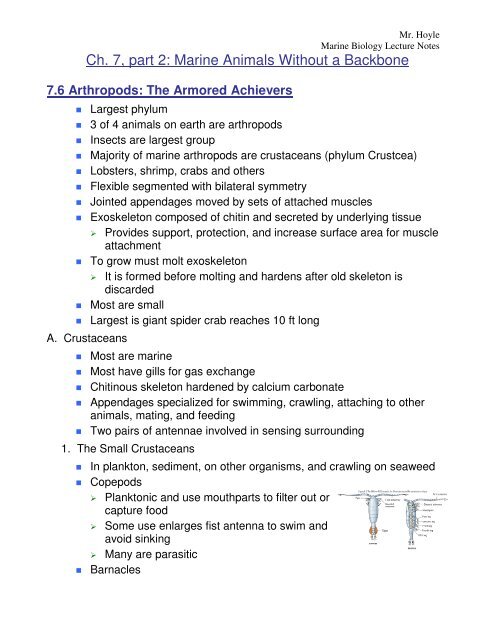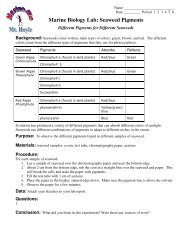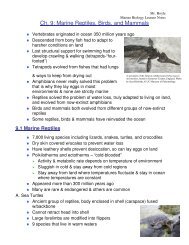Marine Animals Without a Backbone - Mr. Hoyle's Science Page
Marine Animals Without a Backbone - Mr. Hoyle's Science Page
Marine Animals Without a Backbone - Mr. Hoyle's Science Page
Create successful ePaper yourself
Turn your PDF publications into a flip-book with our unique Google optimized e-Paper software.
<strong>Mr</strong>. Hoyle<strong>Marine</strong> Biology Lecture NotesCh. 7, part 2: <strong>Marine</strong> <strong>Animals</strong> <strong>Without</strong> a <strong>Backbone</strong>7.6 Arthropods: The Armored Achievers Largest phylum 3 of 4 animals on earth are arthropods Insects are largest group Majority of marine arthropods are crustaceans (phylum Crustcea) Lobsters, shrimp, crabs and others Flexible segmented with bilateral symmetry Jointed appendages moved by sets of attached muscles Exoskeleton composed of chitin and secreted by underlying tissue Provides support, protection, and increase surface area for muscleattachment To grow must molt exoskeleton It is formed before molting and hardens after old skeleton isdiscarded Most are small Largest is giant spider crab reaches 10 ft longA. Crustaceans Most are marine Most have gills for gas exchange Chitinous skeleton hardened by calcium carbonate Appendages specialized for swimming, crawling, attaching to otheranimals, mating, and feeding Two pairs of antennae involved in sensing surrounding1. The Small Crustaceans In plankton, sediment, on other organisms, and crawling on seaweed Copepods Planktonic and use mouthparts to filter out orcapture food Some use enlarges fist antenna to swim andavoid sinking Many are parasitic Barnacles
<strong>Mr</strong>. Hoyle<strong>Marine</strong> Biology Lecture Notes Filter feeders that unusually live attached tosurfaces including living organisms like crabsand whales Many are very particular what they attach to At the top of their calcareous plates is anopening to allow cirri (feathery appendages)to sweep the water Cirri are legs Some highly modified do not have plates andare parasitic Have crustacean larvae that swim and attach to surfaces beforemetamorphosing into adults Amphipods Have curved body that is flattened sideways Head and tail typically curve downward withspecialized appendages Beach hopers, common in shore debris,spring by briskly stretching their curved bodies Some crawl among seaweed, burrow in whales, and planktonic Isopods Found in same places as amphipods Main part of body has legs that are all similar Dorsoventrally flattened (a flat back) Fish lice (no relation to bird or land mammals lice-insects) areparasitic Krill or euphausiids Planktonic, shrimp-like with head fused with body segments to formcarapace covering anterior half Filter feed on diatoms and other plankton Common in polar waters and aggregating into giant schools Most exclusive food source for whales, penguins, and fishes2. Shrimps, Lobsters, and Crabs Decapods (ten legs) largest group Largest crustaceans in size Have great commercial importance 5 pair of legs, pereopods, first pair are claws used for feeding adefense
<strong>Mr</strong>. Hoyle<strong>Marine</strong> Biology Lecture Notes Maxillipeds closer to mouth, turned forward, and specialized to sort outfood and push it to mouth Well developed carapace encloses the cephalthorax The rest of body is abdomen Shrimp and lobsters Laterally compressed with elongatedabdomen (tail) Shrimp are scavengers feeding ondetritus on the bottom Many colorful shrimp live in tropics onsurfaces of other invertebrates orremove parasites from the skin of fishwhile other live in deep ocean Ghost or mud shrimp live in mud <strong>Marine</strong> and the clawless spiny lobster are nocturnal and hide duringthe day in rock or coral crevices Scavengers and predators that crush molluscs and sea urchins Hermit crabs (not true crabs) hide long soft abdomen in emptyshells, some cover the shell with sea anemones and sponges foradded protection Crabs Abdomen small tucked under compact andtypically broad cephalthorax V-shape abdomen is male, U-shape is female Highly mobile and walk sideways Most diverse of the decapods Scavengers, predators, some have specializeddiets of seaweeds, organic matter in mud, or coralmucus Live along rocky shores or sandy beaches Land crabs live most of life on land but return to ocean to releaseeggsB. Biology of Crustaceans1. Feeding and Digestion Filter feeding is common in small crustaceans Stiff, hair-like bristles on some appendages to capture food particles Other appendages move food from bristles to mouth
<strong>Mr</strong>. Hoyle<strong>Marine</strong> Biology Lecture Notes Some appendages modified to pierce or suck in parasitic copepods Stomach has chitinous teeth or ridges for grinding and bristles forsifting Decapods has 2 chambered stomach connected to digestive gland thatsecretes enzymes & absorbs nutrients (extracellular) Intestine ends in an anus Nutrient distributed by open circulatory system Gas exchange occurs in gills attached to appendages Gills lie under carapace bathed by water2. Nervous System and Behavior Simple crustaceans ladder-like but centralized in decapods Small, simple brains but well-developed sensory organs Compound eyes In decapods acts like periscopes Keen sense of smell (sensitive to chemicals in water) Have pair of statocysts for balance Most behaviorally complex of invert. Have special body posture and movement of legs and antennae Help settle disputes between neighbors and courtship3. Reproduction and Life History Sexes separate in most crustaceans Males use specialized appendages to transfersperm directly to female Hermaphroditic species transfer sperm Barnacles have a penis that can stretch toreach others Decapods takes place immediately after moltingand females can store sperm to use on differentbatches of eggs Amhipods and isopods eggs brooded in chamberby lateral extensions of body Decapods carry eggs on pleopods (simmerets) beneath body Most have planktonic larvae type and number of larval stages varywidelyC. Other <strong>Marine</strong> Arthropods1. Horseshoe Crabs (class Merostomata)
Only surviving members Widely represented by fossil records 5 living species and not true crabs<strong>Mr</strong>. Hoyle<strong>Marine</strong> Biology Lecture Notes Live on soft bottoms of shallow waters on Atlanticand Gulf coasts of North America and Southeast Asia Emerge on beaches to reproduce2. Sea Spiders (class Pycnogonida) Superficially resemble spiders Four or more pairs of legs Large proboscis with mouth at tip used to feed on soft invertebratessuch as sea anemones and hydrozoans More common in cold water but do occur throughout oceans3. Insects (class Insecta) 3 pairs of legs as adults Rare in the sea Live a waters edge scavenging for seaweeds, barnacles, and rocks Inhabit decaying seaweed that accumulates at high tide7.7 Lophophorates Special feeding structure the lophophore is ciliated tentacles arrangesin horseshoe-shaped, circular or coiled Suspension feeders with cilia creating current Lack segmentation, bilateral symmetry, a coelom and U-shaped gutA. Bryozoans (moss animals) (phylum Ectoprocta) Form colonies on seaweeds, rocks, and other surface Consist of minute inter connected individualszooidsthat secret skeleton of various shapes Colonies or either encrusting or upright Lophophore is retractable U-shaped gut ends in anus outside edge oflophophoreB. Phoronids Worm-like and build tubes made of sand grains Horseshoe-shape or circular lophophore and U-shaped gut Burrow in sand or attaching tubes to rocks in shallow water Most only a few cm long
<strong>Mr</strong>. Hoyle<strong>Marine</strong> Biology Lecture NotesA. Lamp Shells or Brachiopods (phylum Brachiopods) Shell w/two valves dorsal and ventral When valves open shows lophophore w/at least 2 coiled and ciliated Attach to tocks or burrowing in soft sediment7.8 Arrow Worms Phylum (Chaetognatha) Smallest animal phyla All marine only 100 species Most common and important member of plankton Almost transparent streamlined with fish-like fins and tail Head has eyes, grasping spines and teeth Range from few mm to 10 cm Voracious carnivores w/efficient sensory structure to detect prey Prey on small crustaceans, eggs, and larvae of fishes Most of time motionless but will swim in rapid darting movement to grabprey7.9 Echinoderms: Five-Way Symmetry Phylum Echinomdermata Bilateral symmetry for plantonic larvae Pentamerous radial symmetry(five parts) for adult No head, anterior or ventralside Oral surface is where themouth is located Complete digestive tract, welldeveloped coelom & internalskeleton (endoskeleton) Endoskeleton is covered by thin layer of ciliated tissue Spines and pointed bumps give spiny appearance Water vascular system-water-filled canals Tube feet are muscular extensions of canals When extended filled with water by the action of muscular sacs(ampullae) that extend inside body opposite of tube feet Tube feet often end in a sucker used for attachment, locomotion andreceiving chemical and mechanical stimuli. In sea stars and sea
<strong>Mr</strong>. Hoyle<strong>Marine</strong> Biology Lecture Notesurchins system connects to outside through madreporite (porousplateA. Types of Echinoderms1. Sea Stars (class Asteroidea) Starfish with most having 5 arms radiating fromcentral disk Some could have 50 arms Tube feet radiate from ambulacral grove Move slowly in any direction by reaching out tubefeet and pulling along Endoskeleton interconnected calcium carbonate plates Allow some flexibility in arms Aboral surface covered w/spines modified into pincer-like organscalled pedicelariae that help keep surface cleanPredators of bivalves, snails, barnacles, & other attached or slowmoving animal2. Brittle Stars (class Ophiuroidea) Very long flexible and sharply demarcated from central disk Has swift, snake-like movements Feet lack suckers & used for feeding Eat detritus and small animals from bottom of water Particles collected by tube feet & passed from foot to foot to mouth Lack anus Widely distributed but hard to see hiding under rocks and corals orcover themselves with mud or sand3. Sea Urchins (class Echinoidea) Endoskeleton forms round rigid shell-like test w/movable spines Locomotion by spines, jointed to sockets in test, and sucker-tippedtube feet 5 rows of ambulacral groves w/tube feet extend outer surface of sphere Mouth on bottom and anus on top Plates that make up test can be seen cleaned of spines & tissue
<strong>Mr</strong>. Hoyle<strong>Marine</strong> Biology Lecture Notes Bands of pores correspond to bands of tube feet Graze on attached or drifting seaweeds and seagrasses Also ingest detritus and encrusting animals (sponges and bryozoans) Mouth has jaws and muscles (Aristotle’s lantern) used to bite off algaeand bits of food from bottom Common on rock shores Heart urchins and sand dollars adapted to live in soft bottoms havingflatten bodies and short spines Deposit feeders use tube feet & mucus to pick up organic matter4. Sea cucumbers (class Holothuroidea) Worm-like, do not have spines, & lack radialsymmetry Lies on side w/5 rows of tube feetOral and aboral are at ends Endoskeleton composed of microscopic calcareousspicules thought warty tough skin Deposit feeders w/tube feet around mouth modified into branchedtentacles used to pick up or scoop sediment Some burrow or hide and extend only tentacles to obtain food Some secrete toxins Discharge sticky sometimes toxic filaments through anusEvisceration- sudden expulsion of gut or internal organs throughmouth or anus to distract predator Can grow back organ5. Crinoids (class Crinoidea) Suspension feeders that use out stretchedfeather arms to obtain food Feather stars and sea lilies Sea lilies restricted to deep water & attachpermanently to bottom Feather star perch and crawl on hard bottoms inboth shallow and deep water
<strong>Mr</strong>. Hoyle<strong>Marine</strong> Biology Lecture Notes Upside down brittle star w/ ambulacral grooves and mouth directedupward Five –200 arms because of branching of original 5 Have side branches w/tube feet secreting mucus to catch food particles Food gets to mouth with ciliated ambulacral groovesA. Biology of Echinoderms1. Feeding a Digestion Most sea stars carnivores Feed by everting part of stomach inside out through mouth envelop thefood Stomach secretes digestive enzymes made by digestive glands thatextend into arms Food carried to glands for absorption and stomach pulled back inside Intestine short or missing Brittle stars and crinoids simple short guts and brittle stars lack anus Sea urchin and sea cucumber long gut Adaptation in sea urchin to digest seaweed because seaweedharder to digest Sea cucumbers adapted to pick up large amount of sediment todigest Nutrients & oxygen transported in ceolomic fluid Sea stars & sea urchins gas exchange take place across small,branched projections Sea cucumbers water drawn through anus to respiratory trees Respir. trees extensions of gut2. Nervous System and Behavior Presence of nerve net Coordinates movement of tube feet & spines No brain Do have come complex behavior like sea cucumbers righting whenturned over and camouflage3. Reproduction and Life History
Sexes are separate in most 5 or more gonads shed sperm or eggs into water<strong>Mr</strong>. Hoyle<strong>Marine</strong> Biology Lecture Notes Spawn all at once because the gametes do not survive long in thewater Fertilized egg develops into ciliated, bilateral larvae in plankton anddoes not obtain radial symmetry until metamorphosis Some do not develop into larvae and are brooded in special pouchesor under body Reproduce asexually by separation of disk andregenerating the resulting other half Some sea stars a severed arm can grow into a newindividual7.10 Hemichordates: A “Missing Link”? Phylum Hemichordata Share some characteristic of echinoderms and chordates, evolutionarylinking these two groups Some have larvae stage like echinoderms & dorsal, hollownerve cord and openings along anterior part of gut likechordates Examples acorn worms, worm like deposit feeders that livefree or in U-shaped tubes Some found around hydrothermal vents 8-45 cm long Ingest sediment like sea cucumbers using thick mucus-secretingproboscis to collect organic material7.11 Chordates without a <strong>Backbone</strong> Phylum Chordata 3 subgroups 2 invertebrates & 1 vertebrate Invertebrates called protochordates All developing chordates including humans have single hollow nervecord along dorsal side, gill slits, notochord (flexible rod supports alongnerve cord and gut), and post anal tail Have ventral heart
A. Types of1. Tunicates Largest group All are marine Sea squirts Sac like bodies attach to hard surfaced or softsediment Sessile Body protected by tunic leathery, gelatinous outercovering<strong>Mr</strong>. Hoyle<strong>Marine</strong> Biology Lecture Notes Filter feeders water flow through incurrent siphon filtered by ciliatedsieve like sacs U-Shaped gut where filtered water is expelled through excurrent siphon Some colonial forming clumps of individuals, and other of circular,flower-like arrangement of individuals sharing common tunic andexcurrent siphon Planktonic larvae known as tadpole larvae have gill slits, dorsal nervecord, notochord, eye, and post anal tail, but adult does not Larvae does not feed & sole purpose is to find place to settle Some are planktonic like Salps Have incurrent and excurrent siphon Floating colonies Larvaceans planktonic tunics Retain body of tadpole through life Secretes complex, delicate gelatinous house for protection andfilters water for food2. Lancelets 7 cm long Laterally compressed & elongated like a fish Has all chordate characteristic lack only backbone Inhabit soft bottoms Filter feeders, use gill slits to capture andconcentrate organic particles





